
Do the Oldest and Weakest Wolves Really Lead the Pack?
A photograph of a wolf pack is commonly shared with an inaccurate description of the behavior of wolves., published dec. 21, 2015.
About this rating
In December 2015, a photograph of a wolf pack marching through the snow began circulating via Facebook along with an inaccurate description about its hierarchy:
"A wolf pack: the first 3 are the old or sick, they give the pace to the entire pack. If it was the other way round, they would be left behind, losing contact with the pack. In case of an ambush they would be sacrificed. Then come 5 strong ones, the front line. In the center are the rest of the pack members, then the 5 strongest following. Last is alone, the alpha. He controls everything from the rear. In that position he can see everything, decide the direction. He sees all of the pack. The pack moves according to the elders pace and help each other, watch each other."
While we don't know exactly who penned the dubious description attached to the picture, the earliest iteration we've found so far came from an Italian-language Facebook post dated 17 December 2015. This post was translated into English on 20 December 2015 and quickly went viral. -->
Despite the image's popularity, however, the attached description of the inner workings of a wolf pack are inaccurate.
The photograph shown was taken by Chadden Hunter and featured in the BBC documentary Frozen Planet in 2011, with its original description explaining that the "alpha female" led the pack and that the rest of the wolves followed in her tracks in order to save energy:
A massive pack of 25 timberwolves hunting bison on the Arctic circle in northern Canada. In mid-winter in Wood Buffalo National Park temperatures hover around -40°C. The wolf pack, led by the alpha female, travel single-file through the deep snow to save energy. The size of the pack is a sign of how rich their prey base is during winter when the bison are more restricted by poor feeding and deep snow. The wolf packs in this National Park are the only wolves in the world that specialize in hunting bison ten times their size. They have grown to be the largest and most powerful wolves on earth.
While this description is more accurate than the one shared in the viral Facebook post, some researchers would nonetheless dispute the use of the term "alpha." In David Mech's 1999 paper "Alpha Status, Dominance, and Division of Labor in Wolf Packs," he argued that the concept of an "alpha" wolf who asserts his or her dominance over other pack members doesn't actually exist in the wild:
Labeling a high-ranking wolf alpha emphasizes its rank in a dominance hierarchy. However, in natural wolf packs, the alpha male or female are merely the breeding animals, the parents of the pack, and dominance contests with other wolves are rare, if they exist at all. During my 13 summers observing the Ellesmere Island pack, I saw none. Thus, calling a wolf an alpha is usually no more appropriate than referring to a human parent or a doe deer as an alpha. Any parent is dominant to its young offspring, so "alpha" adds no information. Why not refer to an alpha female as the female parent, the breeding female, the matriarch, or simply the mother? Such a designation emphasizes not the animal's dominant status, which is trivial information, but its role as pack progenitor, which is critical information.
This photograph is "real" in the sense that it shows a pack of wolves in Wood Buffalo National Park, but the pack is not being led by the three oldest members and trailed by an "alpha" wolf, as implied by a viral Facebook post. Instead, one of the stronger animals leads the group in order to create a path through the snow for them.
Mech, L. David. "Alpha Status, Dominance, and Division of Labor in Wolf Packs." Canadian Journal of Zoology 77:1196-1203 (1999).
By Dan Evon
Dan Evon is a former writer for Snopes.
Article Tags
- Skip to global NPS navigation
- Skip to the main content
- Skip to the footer section

Exiting nps.gov
Wolf ecology basics.
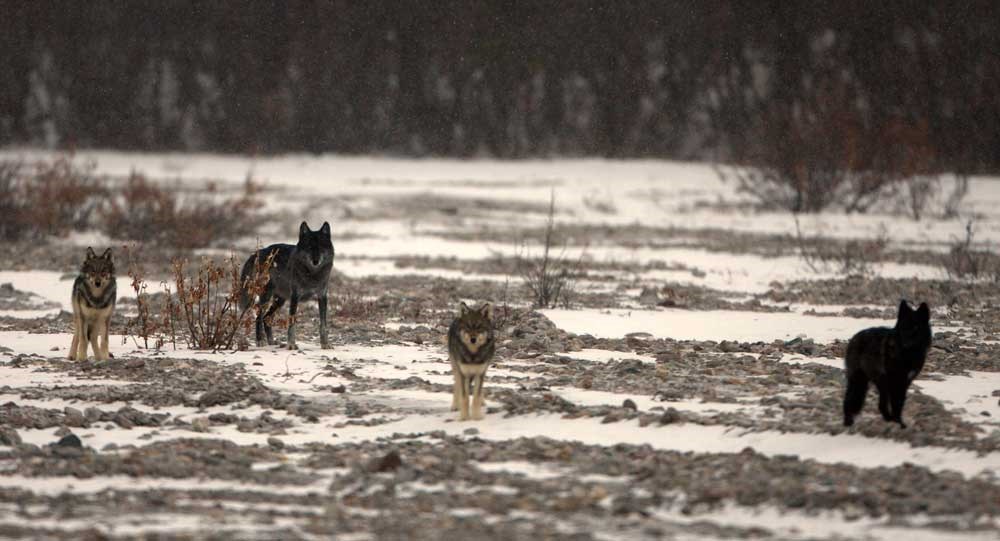
NPS Photo / Steve Arthur
Leaving Home
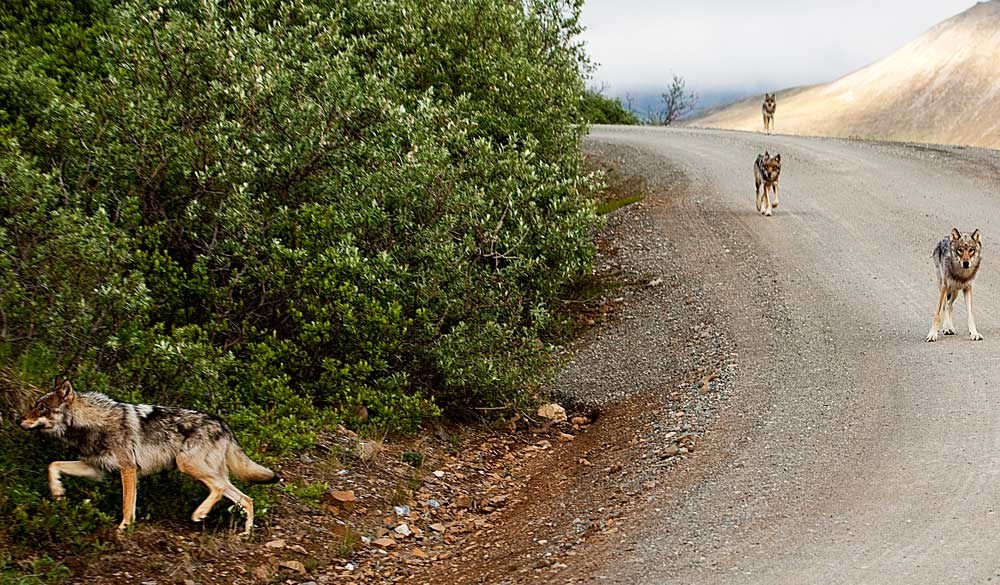
NPS Photo / Nathan Kostegian
Leader of the Pack
- Leading pack travel
- Scent marking
- Food ownership
Wolf Territories
Wolves in parks.
Learn more about wolves and wolf research at Denali National Park, in Alaska.
Learn about wolves and wolf research at Yellowstone National Park
Learn more about wolves and wolf research at Yukon-Charley Rivers National Preserve, in Alaska.
Learn more about wolves and wolf research at Lake Clark National Park, in Alaska.
Learn more about wolves and wolf research at Voyageurs National Park, in Minnesota.
Learn more about wolves and wolf research at Isle Royale National Park, in Michigan.
Last updated: October 22, 2021
The Zoo is free to visit, but entry passes are required for all guests, including infants.
Today's hours: 8 a.m. to 6 p.m. (last entry 5 p.m.)
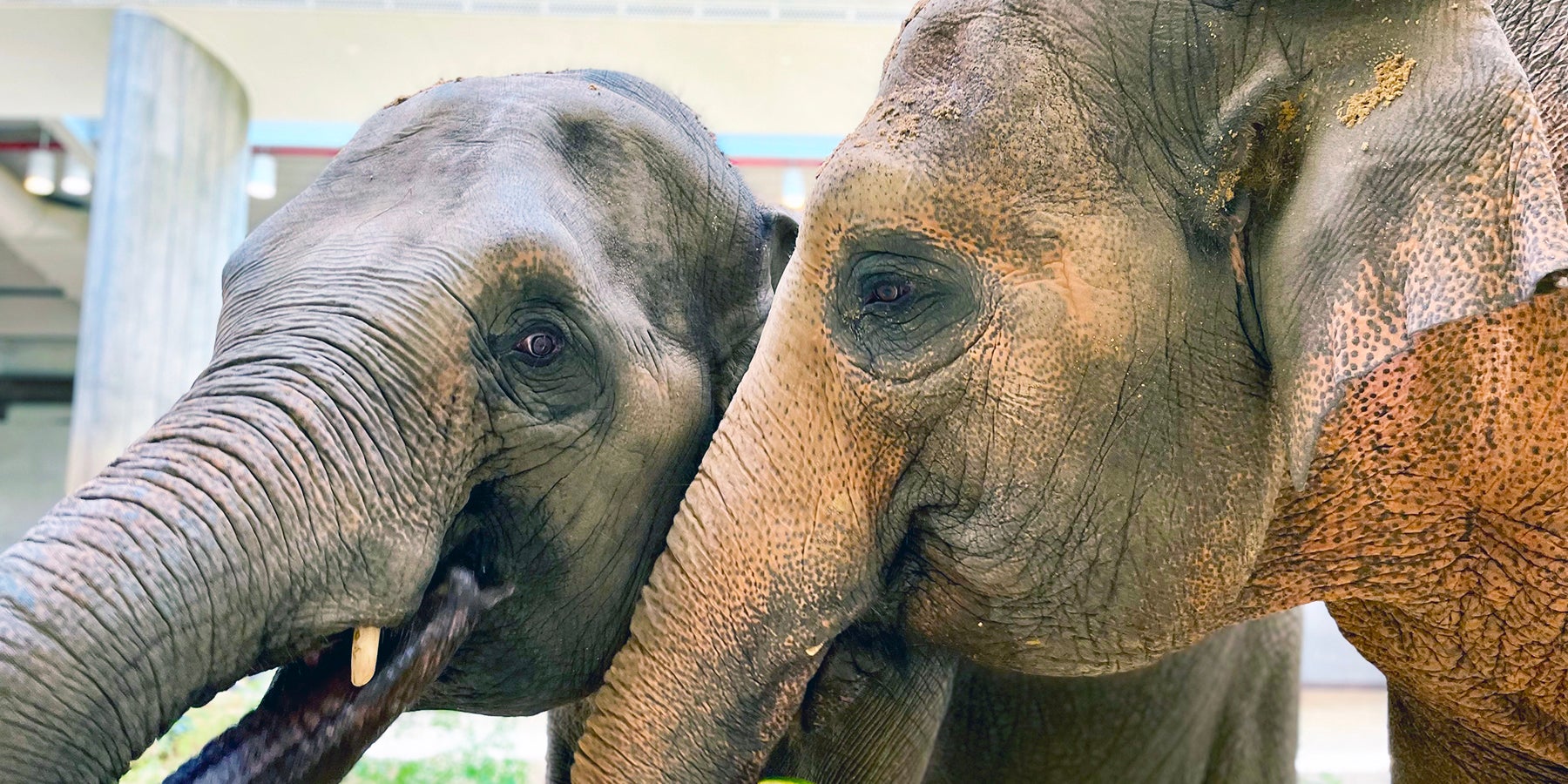
Elephant Cam
See the Smithsonian's National Zoo's Asian elephants — Spike, Bozie, Kamala, Swarna and Maharani — both inside the Elephant Community Center and outside in their yards.

Now more than ever, we need your support. Make a donation to the Smithsonian's National Zoo and Conservation Biology Institute today!

Become a Member
Members are our strongest champions of animal conservation and wildlife research. When you become a member, you also receive exclusive benefits, like special opportunities to meet animals, discounts at Zoo stores and more.
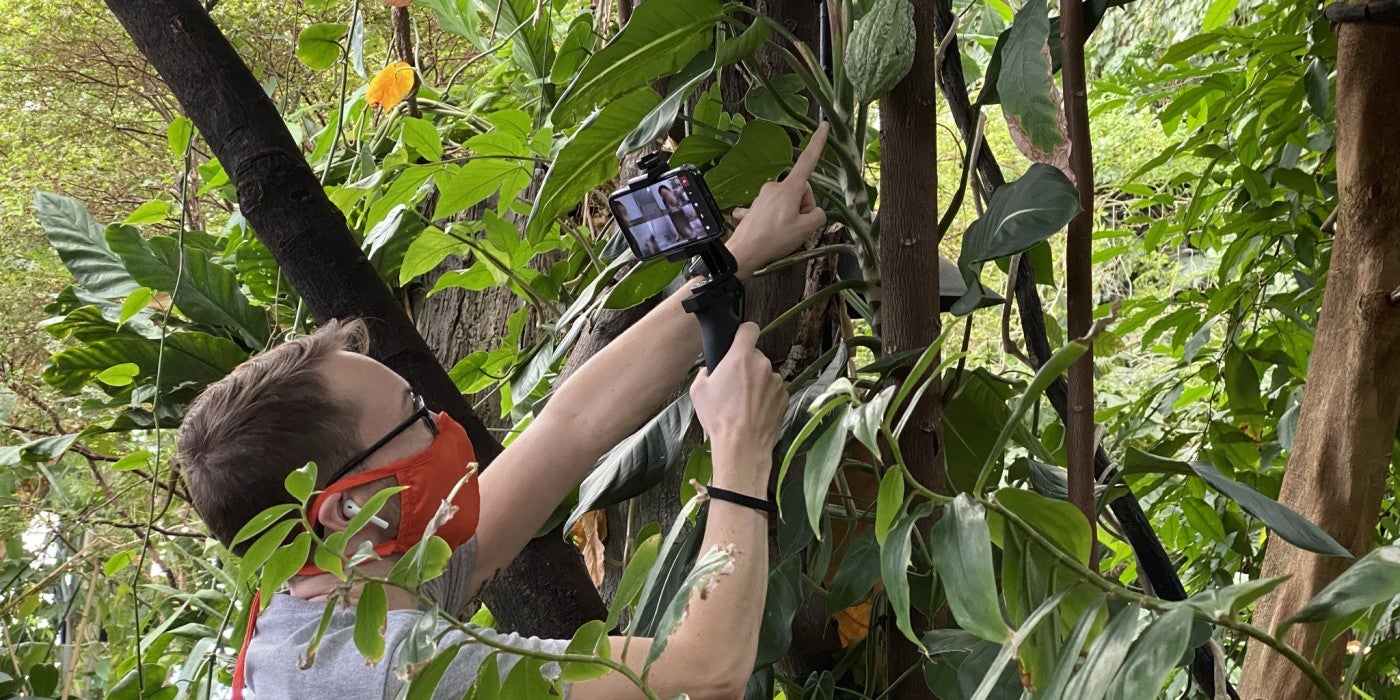
Education Calendar
Find and register for free programs and webinars.
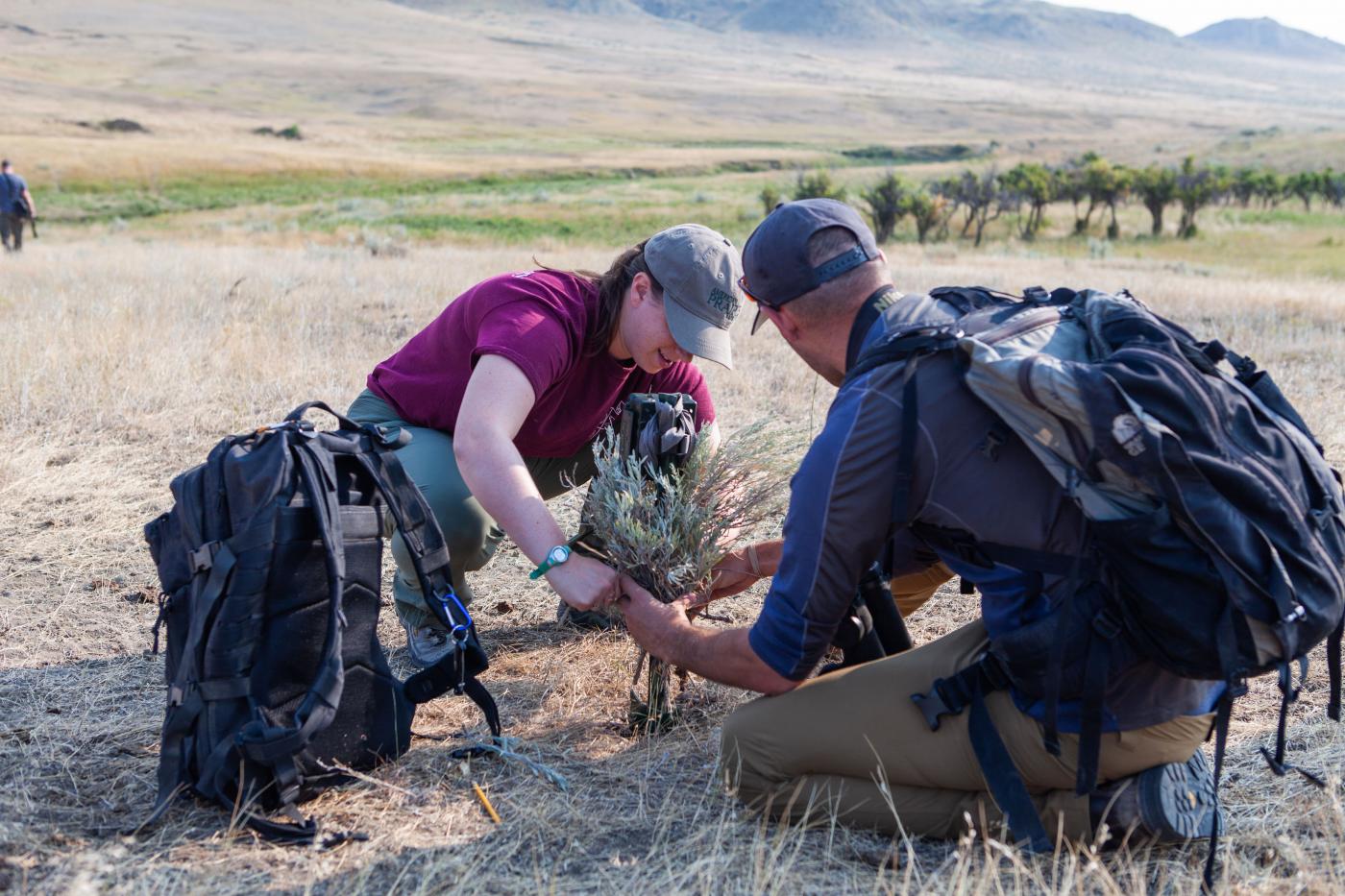
About the Smithsonian Conservation Biology Institute
Why Do Wolves Howl? And Other Top Wolf Questions Answered
You asked the internet, we answered..
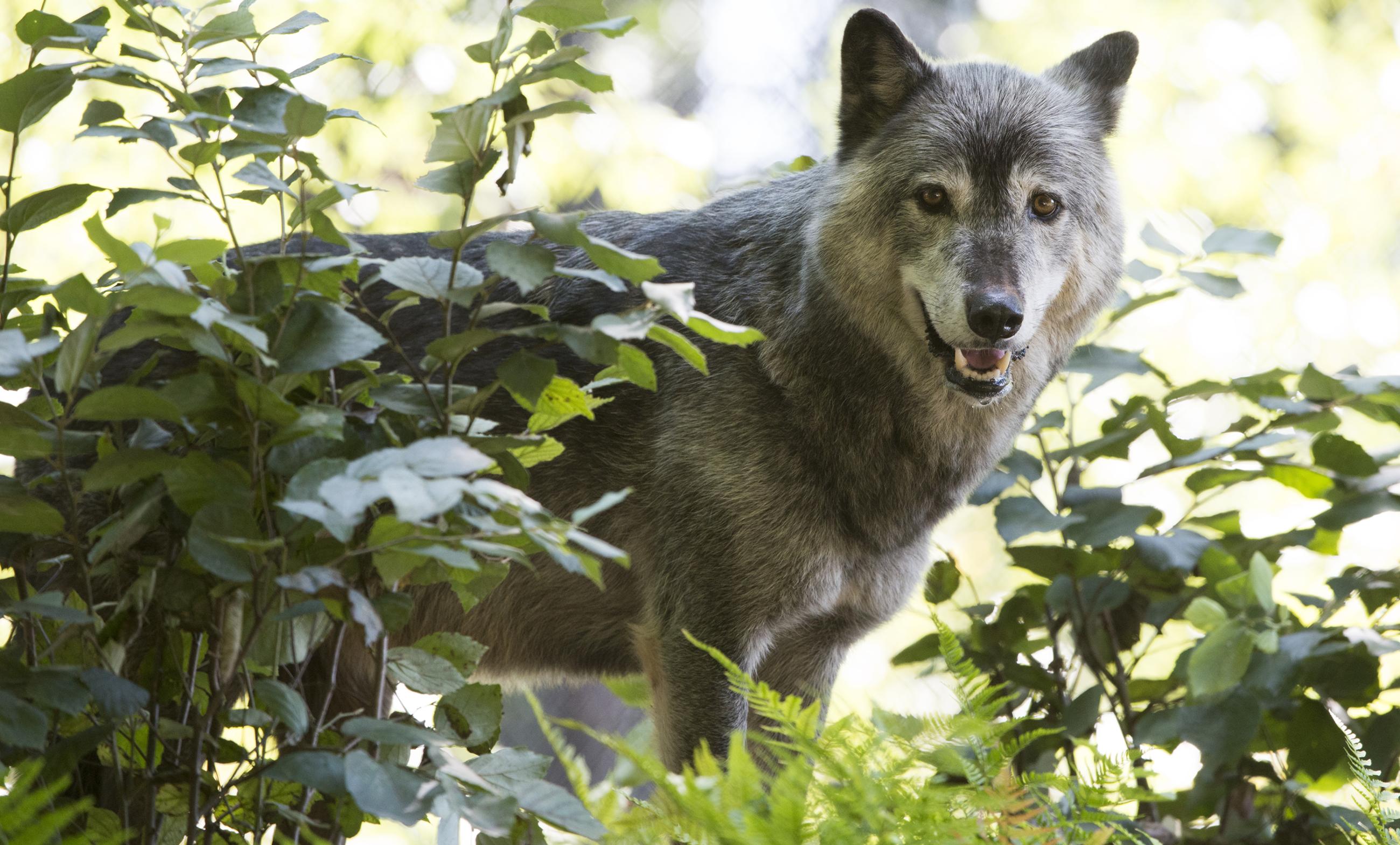
Today, we answer some of the most-searched questions about gray wolves, the largest members of the canine family!
Why do gray wolves howl at the moon?
We hate to burst your bubble, but it is a myth that wolves howl at the moon!
Howling may be heard at night, but it is not a behavior directed at the moon. Instead, it is used as a social rally call, a hail to hunt or as a territorial expression. Did you know that individuals have different howls that can be heard by other wolves 6-7 mile away?
A howl can even help a lost wolf find its way home. A wolf separated from its pack uses a “lonesome howl” — a shortened call that rises in pitch. If answered, the wolf then responds with deep, even howls to inform the pack of its location.
Do gray wolves hibernate?
No, gray wolves stay active throughout the winter. One of the few times they will seek shelter is to create maternity dens. These dens may be in rock crevices, hollow logs or overturned stumps, but most often are burrows dug by the parents.
Why do gray wolves travel in packs?
The gray wolf is one of the most social carnivores. A wolf pack typically has five to eight individuals, but as many as 36 have been reported in one pack. These family groups typically consist of an adult pair, called the alpha, and their offspring.
The alpha pair guides the group’s activity and takes control at critical times, such as during a hunt. A young wolf may venture out on its own, exploring the fringes of its territory before deciding whether to leave its parental pack behind.
How do gray wolves communicate?
In addition to howling, barking and growling, gray wolves use scent marking to maintain pack territories. Body language is also an important communication tool.
Dominant wolves may display raised hackles (the hair on the back of the neck), bared teeth, wrinkled foreheads and erect, forward-pointing ears. Conversely, a less dominant animal may lower its tail and body position, expose its throat, peel back its lips and fold back its ears.
Do gray wolves mate for life?
A wolf pack’s alpha pair is typically the only pair to breed and may mate for life.
Do gray wolves have predators?
Gray wolves once had one of the largest natural ranges of any terrestrial mammal in the Northern Hemisphere, but expansion into the western U.S. placed wolves and humans in conflict from the start. Cattle ranches believed wolves were a threat to their livelihood, and a history of hunting and poisoning devastated wolf populations, bringing them to the brink of extinction.
In 1973, the Endangered Species Act helped reestablish wolf populations. A combination of legal protection, human migration to more urban areas and land-use changes has helped stabilize them since, and in 1995, they were reintroduced to the northern Rocky Mountains.
How do gray wolves hunt?
Hunting in packs allows gray wolves to take down prey larger than themselves, including caribou, moose, deer and bison. They often hunt at night and will catch prey as a team or chase prey toward the remaining members of the pack as a trap.
What do gray wolves eat?
Gray wolves eat about 3-4 pounds of food per day. In addition to hunting large prey, they also catch beavers, rabbits and fish. They will even eat the occasional berry.
Visit American Trail to see the Smithsonian’s National Zoo’s gray wolves , Crystal and Coby.
What are gray wolves?
Wolves are legendary because of their spine-tingling howl, which they use to communicate . A lone wolf howls to attract the attention of his pack, while communal howls may send territorial messages from one pack to another. Some howls are confrontational. Much like barking domestic dogs, wolves may simply begin howling because a nearby wolf has already begun.
Population and conservation
Wolves are the largest members of the dog family. Adaptable gray wolves are by far the most common and were once found all over the Northern Hemisphere. But wolves and humans have a long adversarial history . Though they almost never attack humans, wolves are considered one of the animal world's most fearsome natural villains. They do attack domestic animals, and countless wolves have been shot, trapped, and poisoned because of this tendency.
In the lower 48 states, gray wolves were hunted to near extinction, though some populations survived and others have since been reintroduced. Few gray wolves survive in Europe, though many live in Alaska, Canada, and Asia.
Wolf pack behavior
Wolves live and hunt in packs of around six to ten animals. They are known to roam large distances, perhaps 12 miles in a single day. These social animals cooperate on their preferred prey—large animals such as deer, elk, and moose. When they are successful, wolves do not eat in moderation. A single animal can consume 20 pounds of meat at a sitting. Wolves also eat smaller mammals, birds, fish, lizards, snakes, and fruit.
Wolfpacks are established according to a strict hierarchy, with a dominant male at the top and his mate not far behind. Usually this male and female are the only animals of the pack to breed. All of a pack's adults help to care for young pups by bringing them food and watching them while others hunt.
Did You Know?
- It’s believed that wolves were first tamed in East Asia about 15,000 years ago.
- In Canada, beachcombing wolves swim between islands, eating crabs, clams, and other tidbits.
- Gray wolves are the planet’s most widespread large land mammals after humans and livestock.
- A wolf pack is two or more wolves that have a defined territory.
- Wolves can go for more than a week without eating.
- Environment
- Perpetual Planet
History & Culture
- History & Culture
- History Magazine
- Mind, Body, Wonder
- Paid Content
- Terms of Use
- Privacy Policy
- Your US State Privacy Rights
- Children's Online Privacy Policy
- Interest-Based Ads
- About Nielsen Measurement
- Do Not Sell or Share My Personal Information
- Nat Geo Home
- Attend a Live Event
- Book a Trip
- Inspire Your Kids
- Shop Nat Geo
- Visit the D.C. Museum
- Learn About Our Impact
- Support Our Mission
- Advertise With Us
- Customer Service
- Renew Subscription
- Manage Your Subscription
- Work at Nat Geo
- Sign Up for Our Newsletters
- Contribute to Protect the Planet
Copyright © 1996-2015 National Geographic Society Copyright © 2015-2024 National Geographic Partners, LLC. All rights reserved
Wolf Facts: Gray Wolves, Timber Wolves & Red Wolves

Wolves are large carnivores — the largest member of the dog, or Canid, family. Wolves are common to all parts of the Northern Hemisphere. They are usually shy and cautious around humans, but unlike the dog, have not been domesticated at all.
There are three species and close to 40 subspecies of wolf, according to the Integrated Taxonomic Information System (ITIS), so they come in many different sizes. The most common type of wolf is the gray wolf, or timber wolf. Adult gray wolves are 4 to 6.56 feet (120 to 200 centimeters) long and weigh about 40 to 175 lbs. (18 to 79 kilograms). As its name indicates, the gray wolf typically has thick gray fur, although pure white or all black variations exist.
Another species, the red wolf, is a bit smaller. They grow to around 4.5 to 5.5 feet long (137 to 168 cm) and weigh 50 to 80 lbs. (23 to 36 kg), according to the Defenders of Wildlife organization.
Wolves are found in North America, Europe, Asia and North Africa. They tend to live in the remote wilderness, though red wolves prefer to live in swamps, coastal prairies and forests. Many people think wolves live only in colder climates, but wolves can live in temperatures that range from minus 70 to 120 degrees F (minus 50 to 48.8 degrees C), according to the San Diego Zoo .
The Eastern wolf — also known as Great Lakes wolf, Eastern timber wolf, Algonquin wolf or deer wolf — has been deemed a distinct species from their Western cousins, according to a review by U.S. Fish and Wildlife Service scientists. Eastern wolves used to live in the northeastern United States, but now remain only in southeastern Canada.
In 2016, the Center Biological Diversity filed a notice of intent to sue the Fish and Wildlife Service to protect red wolves in the United States. According to research published in the journal Science Advances in 2016, though, there is only one type of wolf in North America. DNA testing found that only gray wolves are found on the continent. The research also found that red wolves and Eastern wolves may be hybrids of grey wolves and coyotes.
Wolves hunt and travel in packs. Packs don't consist of many members, though. Usually, a pack will have only one male and female and their young. This usually means about 10 wolves per pack, though packs as large as 30 have been recorded.
Packs have a leader, known as the alpha male. Each pack guards its territory against intruders and may even kill other wolves that are not part of their pack. Wolves are nocturnal and will hunt for food at night and sleep during the day.
Wolves are voracious eaters. They can eat up to 20 lbs. (9 kg) of food during one meal. Since they are carnivores, their meals consist of meat that they have hunted.
Gray wolves usually eat large prey such as moose, goats, sheep and deer. Normally, the pack of wolves will find the weakest or sickest animal in a herd, circle it and kill it together. Wolves are known to attack and kill domestic animals as well as animals they find in the wild.
Red wolves eat smaller prey such as rodents, insects and rabbits. They aren't afraid of going outside their carnivorous diet and will eat berries on occasion, too.
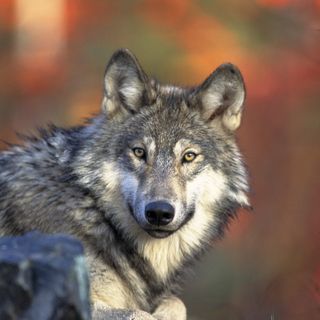
Young wolves are called pups. The leader of the pack and his female mate are usually the only ones in a pack that will have offspring. They mate in late winter. The female has a gestation period of nine weeks and gives birth to a litter consisting of one to 11 pups.
When the pups are born, they are cared for by all of the adult wolves in the pack. Young pups start off drinking milk from their mother, but around five to 10 weeks they will start eating food regurgitated from adult pack members.
At six months, wolf pups become hunters, and at 2 years old they are considered adults. On average, a wolf will live four to eight years in the wild.
Classification/taxonomy
This the classification of wolves, according to ITIS:
Kingdom : Animalia Subkingdom : Bilateria Infrakingdom : Deuterostomia Phylum : Chordata Subphylum : Vertebrata Infraphylum : Gnathostomata Superclass : Tetrapoda Class : Mammalia Subclass : Theria Infraclass : Eutheria Order : Carnivora Suborder : Caniformia Family : Canidae Genus : Canis Species :
- Canis lupus (gray wolf)
- Canis rufus (red wolf)
- Canis lycaon (Eastern wolf)
Conservation status
Though wolves once roamed far and wide, they are very scarce today. The International Union for Conservation of Nature and Natural Resources (IUCN) lists red wolves as critically endangered. According to the National Parks Conservation Association, there are 20 to 80 red wolves currently living in the wild.
The Ethiopian wolf is also listed as endangered by the IUCN. The Eastern wolf is threatened and is protected in Canada.

Other facts
Packs of wolves don't like to stay in one place. They are known to travel as far as 12 miles (20 kilometers) per day.
Wolves have friends. Wolves howl to communicate with other members of the pack. Researchers have found that they howl more to pack members that they spend the more time with.
There are many names for gray wolves. Besides timber wolf, they are also called common wolf, tundra wolf, Mexican wolf and plains wolf.
To help with the red wolf population, wild wolves are given pups that are born in captivity. This is called "fostering."
Wolves also communicate by leaving scent marking such as urine or feces on a trail.
Wolves are very similar to dogs in behavior. They love to play, chew on bones but will growl or snarl when threatened.
Other resources
- National Geographic: Wolf
- World Wildlife Federation: Arctic Wolf
- World Wildlife Federation: Gray Wolf
- BBC Nature: Wolf
Sign up for the Live Science daily newsletter now
Get the world’s most fascinating discoveries delivered straight to your inbox.

Why do cats' claws retract but dogs' claws don't?
Southern grasshopper mouse: The tiny super-predator that howls at the moon before it kills
How common chemicals — including those in bed sheets — can boost eczema risk
Most Popular
- 2 James Webb telescope confirms there is something seriously wrong with our understanding of the universe
- 3 Eclipse from space: Paths of 2024 and 2017 eclipses collide over US in new satellite image
- 4 Giant, 82-foot lizard fish discovered on UK beach could be largest marine reptile ever found
- 5 Scientists discover once-in-a-billion-year event — 2 lifeforms merging to create a new cell part
- 2 New UTI vaccine wards off infection for years, early studies suggest
- 3 Tweak to Schrödinger's cat equation could unite Einstein's relativity and quantum mechanics, study hints
- 4 Why does striking flint against steel start a fire?
- 5 32 times lasers revealed hidden forts and settlements from centuries ago
- All content
- Rural Alaska
- Crime & Courts
- Alaska Legislature
- ADN Politics Podcast
- National Opinions
- Letters to the Editor
- Nation/World
- Film and TV
- Outdoors/Adventure
- High School Sports
- UAA Athletics
- Food and Drink
- Visual Stories
- Alaska Journal of Commerce (Opens in new window)
- The Arctic Sounder
- The Bristol Bay Times
- Legal Notices (Opens in new window)
- Peak 2 Peak Events (Opens in new window)
- Educator of the Year (Opens in new window)
- Celebrating Nurses (Opens in new window)
- Top 40 Under 40 (Opens in new window)
- Alaska Spelling Bee (Opens in new window)
- Alaska Craft Brew Festival
- Best of Alaska
- Spring Career Fair (Opens in new window)
- Achievement in Business
- Youth Summit Awards
- Lynyrd Skynyrd Ticket Giveaway
- Teacher of the Month
- 2024 Alaska Summer Camps Guide (Opens in new window)
- 2024 Graduation (Opens in new window)
- Alaska Visitors Guide 2024 (Opens in new window)
- 2023 Best of Alaska (Opens in new window)
- Alaska Health Care (Opens in new window)
- Merry Merchant Munch (Opens in new window)
- On the Move AK (Opens in new window)
- Senior Living in Alaska (Opens in new window)
- Youth Summit Awards (Opens in new window)
- Alaska Visitors Guide
- ADN Store (Opens in new window)
- Classifieds (Opens in new window)
- Jobs (Opens in new window)
- Place an Ad (Opens in new window)
- Customer Service
- Sponsored Content
- Real Estate/Open Houses (Opens in new window)
Why do wolves hunt in packs? The answer might be ravens
A raven moves on from a frosted spruce tree Jan. 5 in Turnagain. (Erik Hill / ADN archive 2017)
People who study animal behavior think they may have found out why wolves hunt in packs: Because ravens are such good scavengers.
Scientists who watched wolves on Isle Royale in Lake Superior came up with the raven-wolf pack theory after puzzling over a question: Why do wolves hunt in large groups when a single wolf can take down a moose?
To find a possible answer, John Vucetich and Rolf Peterson of Michigan Tech and Thomas Waite of Ohio State University examined 27 years of wolf observations on Isle Royale in northern Michigan. Isle Royale, 45 miles long and up to 9 miles wide, sits in the northwest lobe of Lake Superior. A national park, the island supports a population of a few dozen wolves and hundreds of moose. Peterson studied the wolves for more than 30 years, and the researchers used observations from Peterson and his coworkers in the present study.
Peterson's team witnessed a single wolf killing a moose 11 times, which weakened the notion that wolves hunt in packs because of the difficulty of killing a moose without help. Vucetich, Peterson and Waite used the years of data from the Isle Royale wolf study to calculate that — in terms of energy burned and meat gained — wolves would do best hunting in pairs.
A wolf just east of Stony Creek in Denali National Park in 2013. (Jay Elhard / National Park Service)
A 1,000-pound moose is much more than two wolves can eat right away, and that's where the ravens come in. In a study published in Animal Behaviour, the scientists detailed these facts about ravens found by other scientists: Individual ravens can eat and carry away up to 4 pounds of food per day from a large carcass. Ravens were responsible for moving half of a 660-pound moose carcass from a kill site in the Yukon Territory.
During the 27 years of Peterson's wolf observations used in the recent study, ravens were present at every wolf kill, often within 60 seconds of a moose's death. Noted raven researcher Bernd Heinrich has suggested that ravens evolved with wolves, with ravens possibly leading wolves to moose or caribou, and then later feeding upon the carcasses torn open by wolves.
That the wolf pack exists because of ravens is a new idea, supported by the group's "conservative assumption" that wolves lose up to 44 pounds of food per day to ravens while feeding upon a carcass, and that a pair of wolves loses about 37 percent of a moose carcass to ravens while a pack of six wolves loses just 17 percent.
Ravens sneak in to eat or carry away scraps of moose flesh and organs while wolves are feeding or resting away from the carcass, and the more ravens there are (researchers have counted up to 100 near kill sites), the harder it is for wolves to chase them off.
The urge not to die by starvation may drive wolves to kill "approximately twice as many large prey as would be needed in the absence of ravens," the scientists wrote. They also wrote that 85 to 90 percent of carnivore species hunt alone, and the wolf pack might not exist if not for the pesky, bold raven.
Ned Rozell | Alaska Science
Ned Rozell is a science writer with the Geophysical Institute at the University of Alaska Fairbanks.
Leaving the Pack
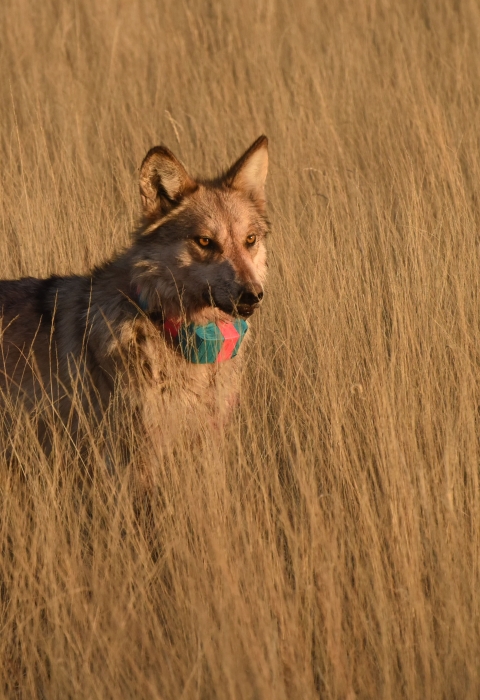
Every year, individual wolves across America leave the pack they were born into (called a “natal pack”) and go solo, becoming a “lone wolf” in the wild. While some may think it’s a brave choice—one reserved for the truly independent—a wild wolf’s decision to leave a pack and strike out alone is quite common. Known as “dispersing,” this is how wolves find mates and form new packs.
To understand why and when a wolf leaves its pack, it’s important to understand a few basics about pack dynamics in the wild.
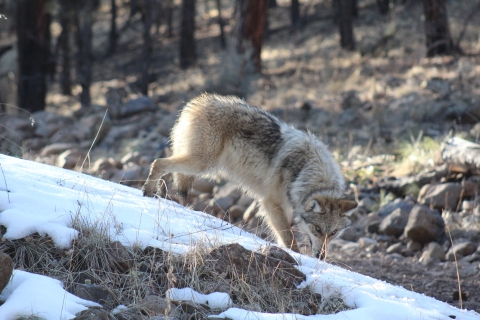
All in the family
A wolf pack is essentially a family unit. There is a breeding pair (one male and one female) who are in charge. The rest of the pack is made up of their offspring—including new pups, yearlings and subadults. Occasionally, a dispersing wolf from another pack will join an existing pack. This most often occurs when either the breeding male or female dies, and a new partner is needed.
The family dynamic of a pack allows young wolves to learn how to survive in the wild from their parents and siblings. As part of a pack, wolves learn to hunt, avoid danger, and defend themselves.
A wolf pack can vary in size from only two breeding adults up to a multigenerational group containing 10 or more wolves.
As wolf pups age and grow, they venture farther and farther out from their den. By the time they reach six months of age, the young wolves are big enough to travel widely with their pack and assist with hunting elk and deer. By the time juvenile wolves reach 1.5 to 2 years of age they are fully grown and capable of hunting large prey on their own.
Should I stay or should I go?
Wolves reach breeding age at around age 2. Because there is usually only one breeding pair in each pack, a wolf at this age who is ready to find a mate must leave its natal pack.
The decision to leave, however, is not an easy one. Finding food without the help of a pack to hunt is challenging. There is no guarantee of finding a mate. And there’s safety in pack numbers.
“Until dispersal, a wolf lives its entire life in the pack’s territory,” says Colby Gardner, a wolf biologist with the U.S. Fish and Wildlife Service. “This territory is all the wolf has ever known. Leaving a natal pack is much like leaving one’s hometown. It means venturing into new places, which brings new threats like roads, other packs and people.”
The life of a lone wolf is difficult and sometimes dangerous. Yet, the health of wild wolf populations depends on wolves dispersing, finding mates, starting new packs and spreading to new territories.
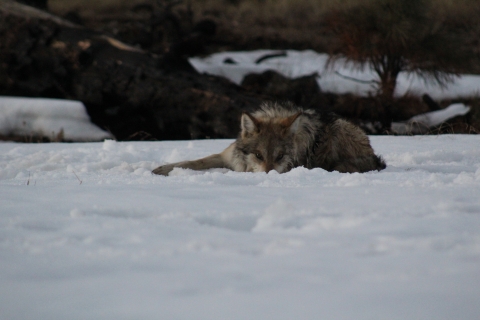
Looking for the one
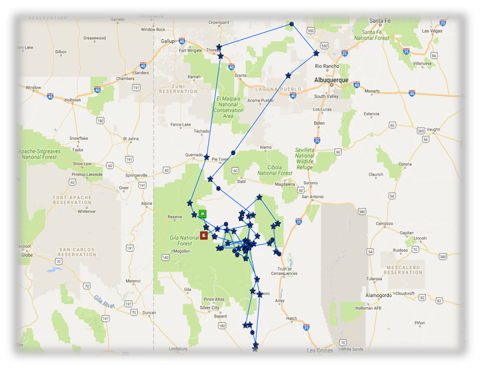
While wolves have been documented dispersing throughout the year, fall and winter are the most common times for it to occur since breeding happens in the late winter.
Once a wolf disperses, it spends its days foraging for food and looking for a partner.
A primary method for finding a mate is through howling. Wolves can hear each other howl over distances of 6 miles in the wild depending on terrain.
Wolves also use their keen sense of smell to find a partner. The information a wolf can glean from a single sniff of another wolf’s urine or scat (poop) is truly amazing - they can learn the gender, diet, social rank, and breeding condition of another wolf by smell alone. Wolves can also tell how recently the scent was left, which helps them track each other across the landscape.
The distance a dispersing wolf must travel, and the time it takes for a wolf to find a new mate, vary greatly. It can be influenced by the number of dispersal-aged wolves in the area’s population.
For the lucky ones, they find a mate and form a new pack. It may take several years for a new pair of wolves to successfully reproduce in the wild. Once they do, their pack can continue to grow, and the cycle repeats itself.
Media Contacts
Related stories.
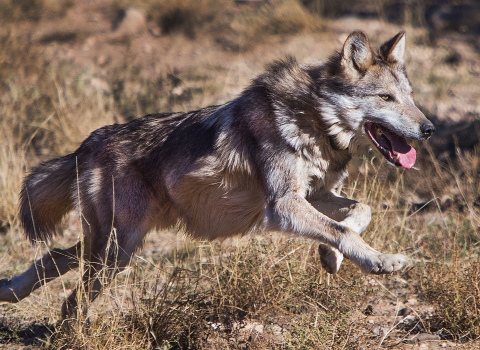
Latest Stories
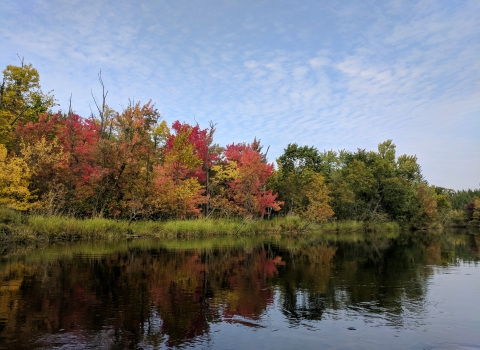
You are exiting the U.S. Fish and Wildlife Service website
You are being directed to
We do not guarantee that the websites we link to comply with Section 508 (Accessibility Requirements) of the Rehabilitation Act. Links also do not constitute endorsement, recommendation, or favoring by the U.S. Fish and Wildlife Service.

- The Social Wolf
Family Groups (or Packs) The Bond Sharing Knowledge The Wolf You Know The Lone Wolf
Wolves are complex, highly intelligent animals who are caring, playful, and above all devoted to family. Only a select few other species exhibit these traits so clearly. Just like elephants, gorillas and dolphins, wolves educate their young, take care of their injured and live in family groups.
Family Groups
A wolf pack is an exceedingly complex social unit—an extended family of parents, offspring, siblings, aunts, uncles, and sometimes dispersers from other packs. There are old wolves that need to be cared for, pups that need to be educated, and young adults that are beginning to assert themselves – all altering the dynamics of the pack.
The job of maintaining order and cohesion falls largely to the alphas, also known as the breeding pair. Typically, there is only one breeding pair in a pack. They, especially the alpha female (the mother of the pack), are the glue keeping the pack together. The loss of a parent can have a devastating impact on social group cohesion. In small packs, human-caused mortality of the alpha female and/or the alpha male can cause the entire pack to dissolve.
After the alphas, wolves second in command are called the betas, followed by mid-ranking wolves, and finally the omegas. Both mid- and low-ranking positions are somewhat fluid. Although an omega may hold that position for many years, it is not unheard of for the pack to pick a new omega and let the other retire.
Living in a pack not only facilitates the raising and feeding of pups, coordinated and collaborative hunting, and the defense of territory, it also allows for the formation of many unique emotional bonds between pack members, the foundation for cooperative living.
Wolves care for each other as individuals. They form friendships and nurture their own sick and injured. Pack structure enables communication, the education of the young and the transfer of knowledge across generations. Wolves and other highly social animals have and pass on what can be best described as culture. A family group can persevere for several generations, even decades, carrying knowledge and information through the years, from generation to generation.
Wolves play together into old age, they raise their young as a group, and they care for injured companions. When they lose a pack mate, there is evidence that they suffer and mourn that loss. When we look at wolves, we are looking at tribes—extended families, each with its own homeland, history, knowledge, and indeed, culture.
Sharing Knowledge:
Wolves communicate, collaborate and share knowledge across generations. The older wolves, as more experienced hunters, share hunting strategies and techniques with younger wolves, passing down knowledge from one generation to the next, maintaining a culture unique to that pack.
The late biologist Gordon Haber observed wolves changing their hunting strategy based on weather, terrain, and prey behavior. Read about Gordon’s research here .
The Lone Wolf:
We often hear the phrase “lone wolf,” an expression of grudging admiration. A lone wolf is often viewed as a rugged individualist, uncompromising and independent, driven to forge his own path, unfettered by the sentimental need for companionship. In reality, few people would ever want to live this way—and, as it turns out, few wolves would either. Wolves, males and females alike, may go through periods alone, but they’re not interested in lives of solitude. A lone wolf is a wolf that is searching, and what it seeks is another wolf. Everything in a wolf’s nature tells it to belong to something greater than itself: a pack. Like us, wolves form friendships and maintain lifelong bonds. They succeed by cooperating, and they struggle when they’re alone. Like us, wolves need one another . Read more…
The Wolf You Know
In our dog companions, we recognize the face, a broad mask that tapers gracefully into a long muzzle. we have looked into the eyes, bright with curiosity. we understand the messages conveyed through posture: the alertness seen in expression, the playfulness of a bow, the confidence or fear betrayed by an animated tail. we can be forgiven for thinking we already know the wolf, for in many ways we already do..
Genetics leaves little doubt that domestic dogs, our canine companions, are descended from wolves. The DNA of any dog is almost exactly the same as that of a wolf.
You can see a lot of your dog in a wolf and a lot of wolf in your dog. They are both social animals. Just like elephants, gorillas and whales, they educate their young, take care of their injured and live in family groups.
The traits that wolves passed on to dogs served us well as we became shepherds and farmers. We capitalized on the wolf’s territorialism to create a dog that steadfastly guarded our flocks and property. We put the wolf’s superior sense of smell and knack for locating prey to use as trackers and retrievers on our own hunts. We transformed the wolf’s skill at harassing and maneuvering big grazing animals into a herding instinct, helping us move our livestock from place to place.
The wolf also passed along to dogs its most indispensable qualities: devotion to its pack, sociability, and a capacity for learning, communication, and expression.
In turning the wolf into the dog, we created the ultimate companion, a faithful friend that can understand our intentions even better than our fellow primates can.
Both wolves and humans brought unique, complementary talents to a relationship that was based on mutual respect. Several scholars agree that humans learned to hunt from wolves.
The relationship between dogs and humans has been so mutually beneficial and enduring that it is clear that we influenced each other’s evolution.
Knowing all that the wolf bequeathed to our beloved dogs, how strange that we reserve for wolves a special hatred that we hold for no other animal.
We brought our domestic dogs along with us, into our pastures, cities and homes.
Wolves are the dogs that stayed behind, favoring their wild ways. Perhaps we can’t forgive them for that.
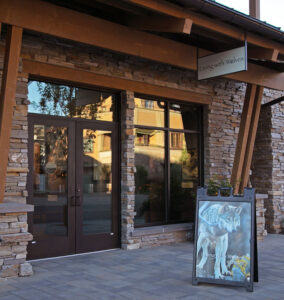
Living with Wolves Museum 580 4th St, Suite 150 Ketchum, ID 83340 208-928-4991
Hours of Operation Tuesday – Saturday 11am – 4pm
A 501(c)3 nonprofit organization Tax ID: 20-4933982
© 2024 Living with Wolves. / 501c3 Non-Profit Organization design by Glick + Fray Privacy Policy
- Visit Our Museum
- Interactive Exhibit
- Meet the Wolf
- How Wolves Hunt
- Wolves & Our Ecosystem
- The Language of Wolves
- Four Perceptions
- Tackling the Myths
- Killing Wolves
- Ranching Solutions
- Educational Resources
- Meet the Pack
- Sawtooth Pack Stories
- Our Observations
- Saying Goodbye
- Our Mission
- Our History
- Our Organization
- Annual Reports
- Programs & Outreach
- Nat Geo Partnership
- Testimonials
- Wolves Need Your Help
- LWW Endowment
- Who to Contact
- Stay Informed
Russia Travel Blog | All about Russia in English
- About our blog
- RussiaTrek.org
Sidebar →
- Architecture
- Entertainment
- RussiaTrek.org News

- Send us a tip with a message
- Support RussiaTrek.org
- Travel Guide to Ukraine
- Comments RSS
← Sidebar
The trains and stations of the Moscow Metro
2 Comments · Posted by Alex Smirnov in Cities , Travel , Video
The Moscow Metro is the third most intensive subway system in the world after Tokyo and Seoul subways. The first line was opened on May 15, 1935. Since 1955, the metro has the name of V.I. Lenin.
The system consists of 12 lines with a total length of 305.7 km. Forty four stations are recognized cultural heritage. The largest passenger traffic is in rush hours from 8:00 to 9:00 and from 18:00 to 19:00.
Cellular communication is available on most of the stations of the Moscow Metro. In March 2012, a free Wi-Fi appeared in the Circle Line train. The Moscow Metro is open to passengers from 5:20 to 01:00. The average interval between trains is 2.5 minutes.
The fare is paid by using contactless tickets and contactless smart cards, the passes to the stations are controlled by automatic turnstiles. Ticket offices and ticket vending machines can be found in station vestibules.
Tags: Moscow city
You might also like:

The bridge over Zolotoy Rog Bay in Vladivostok
The views of St. Petersburg from the TV tower >>
Tomás · August 27, 2012 at 11:34 pm
The Moscow metro stations are the best That I know, cars do not.
Alberto Calvo · September 25, 2016 at 8:57 pm
Great videos! Moscow Metro is just spectacular. I actually visited Moscow myself quite recently and wrote a post about my top 7 stations, please check it out and let me know what you think! :)
http://www.arwtravels.com/blog/moscow-metro-top-7-stations-you-cant-miss
Leave a Reply
XHTML: You can use these tags: <a href="" title=""> <abbr title=""> <acronym title=""> <b> <blockquote cite=""> <cite> <code> <del datetime=""> <em> <i> <q cite=""> <s> <strike> <strong>
- February 2024
- January 2024
- December 2023
- November 2023
- October 2023
- September 2023
- August 2023

Tvel completes development of new fuel for Paks nuclear plant
!{Model.Description}

The full package of documents is handed over to the Hungarian customer, MVM Paks Ltd, for further licensing of the new fuel by the national nuclear power regulator, Tvel said.
The first fuel assemblies have also passed acceptance testing at Tvel's Elemash Machine-building plant in Elektrostal, Moscow region.
The new modification of VVER-440 second generation fuel increases the efficiency of fuel usage and advances the economic performance of the power plant operation, Tvel said.
The engineering contract for development of the new VVER-440 fuel was signed in late 2017. The development and validation work involved a number of Russian enterprises, including OKB Gidropress (a part of Rosatom machine-building division Atomenergomash), Bochvar Institute (material science research facility of TVEL Fuel Company), Elemash Machine-building plant and Kurchatov Institute national research center. At the site of OKB Gidropress research and experiment facility, the new fuel passed a range of hydraulic, longevity and vibration tests .
The first consignment of the modified fuel will be delivered to Paks nuclear power plant later this year. The four-unit Paks nuclear plant, which entered operation between 1982 and 1987 currently operate on a 15-month fuel cycle and supply around 50% of Hungary's electricity.
Photo: Fabrication of new VVER-440 fuel for Paks nuclear plant (Credit: Tvel)
- Terms and conditions
- Privacy Policy
- Newsletter sign up
- Digital Edition
- Editorial Standards

Claudia Looi
Touring the Top 10 Moscow Metro Stations
By Claudia Looi 2 Comments

Komsomolskaya metro station looks like a museum. It has vaulted ceilings and baroque decor.
Hidden underground, in the heart of Moscow, are historical and architectural treasures of Russia. These are Soviet-era creations – the metro stations of Moscow.
Our guide Maria introduced these elaborate metro stations as “the palaces for the people.” Built between 1937 and 1955, each station holds its own history and stories. Stalin had the idea of building beautiful underground spaces that the masses could enjoy. They would look like museums, art centers, concert halls, palaces and churches. Each would have a different theme. None would be alike.
The two-hour private tour was with a former Intourist tour guide named Maria. Maria lived in Moscow all her life and through the communist era of 60s to 90s. She has been a tour guide for more than 30 years. Being in her 60s, she moved rather quickly for her age. We traveled and crammed with Maria and other Muscovites on the metro to visit 10 different metro stations.

Arrow showing the direction of metro line 1 and 2

Moscow subways are very clean
To Maria, every street, metro and building told a story. I couldn’t keep up with her stories. I don’t remember most of what she said because I was just thrilled being in Moscow. Added to that, she spilled out so many Russian words and names, which to one who can’t read Cyrillic, sounded so foreign and could be easily forgotten.
The metro tour was the first part of our all day tour of Moscow with Maria. Here are the stations we visited:
1. Komsomolskaya Metro Station is the most beautiful of them all. Painted yellow and decorated with chandeliers, gold leaves and semi precious stones, the station looks like a stately museum. And possibly decorated like a palace. I saw Komsomolskaya first, before the rest of the stations upon arrival in Moscow by train from St. Petersburg.
2. Revolution Square Metro Station (Ploshchad Revolyutsii) has marble arches and 72 bronze sculptures designed by Alexey Dushkin. The marble arches are flanked by the bronze sculptures. If you look closely you will see passersby touching the bronze dog's nose. Legend has it that good luck comes to those who touch the dog's nose.

Touch the dog's nose for good luck. At the Revolution Square station

Revolution Square Metro Station
3. Arbatskaya Metro Station served as a shelter during the Soviet-era. It is one of the largest and the deepest metro stations in Moscow.

Arbatskaya Metro Station
4. Biblioteka Imeni Lenina Metro Station was built in 1935 and named after the Russian State Library. It is located near the library and has a big mosaic portrait of Lenin and yellow ceramic tiles on the track walls.

Lenin's portrait at the Biblioteka Imeni Lenina Metro Station

5. Kievskaya Metro Station was one of the first to be completed in Moscow. Named after the capital city of Ukraine by Kiev-born, Nikita Khruschev, Stalin's successor.

Kievskaya Metro Station
6. Novoslobodskaya Metro Station was built in 1952. It has 32 stained glass murals with brass borders.

Novoslobodskaya metro station
7. Kurskaya Metro Station was one of the first few to be built in Moscow in 1938. It has ceiling panels and artwork showing Soviet leadership, Soviet lifestyle and political power. It has a dome with patriotic slogans decorated with red stars representing the Soviet's World War II Hall of Fame. Kurskaya Metro Station is a must-visit station in Moscow.

Ceiling panel and artworks at Kurskaya Metro Station

8. Mayakovskaya Metro Station built in 1938. It was named after Russian poet Vladmir Mayakovsky. This is one of the most beautiful metro stations in the world with 34 mosaics painted by Alexander Deyneka.

Mayakovskaya station

One of the over 30 ceiling mosaics in Mayakovskaya metro station
9. Belorusskaya Metro Station is named after the people of Belarus. In the picture below, there are statues of 3 members of the Partisan Resistance in Belarus during World War II. The statues were sculpted by Sergei Orlov, S. Rabinovich and I. Slonim.

10. Teatralnaya Metro Station (Theatre Metro Station) is located near the Bolshoi Theatre.

Teatralnaya Metro Station decorated with porcelain figures .

Taking the metro's escalator at the end of the tour with Maria the tour guide.
Have you visited the Moscow Metro? Leave your comment below.
January 15, 2017 at 8:17 am
An excellent read! Thanks for much for sharing the Russian metro system with us. We're heading to Moscow in April and exploring the metro stations were on our list and after reading your post, I'm even more excited to go visit them. Thanks again 🙂
December 6, 2017 at 10:45 pm
Hi, do you remember which tour company you contacted for this tour?
Leave a Reply Cancel reply
You must be logged in to post a comment.
Please go to the Instagram Feed settings page to create a feed.
Firebird Travel
RUSSIA TRAVEL HOME
Thank you for your enquiry.
RUSSIA TRAVEL PACKAGES A selection of Russian tours to take as they are or adjust to your needs.
THE GOLDEN RING Visit the heart of ancient Russia. What is the Golden Ring?
MOSCOW TOURS What you can see in Moscow.
MOSCOW DAY TRIPS Get out of Moscow and take a relaxing trip to some of these places
ST. PETERSBURG Some of the sights to see in Petersburg
LAKE BAIKAL TOURS Hiking and trekking around the world's deepest lake in the heart of Siberia
RUSSIAN DIGS Come and work in the field on a Russian Archaeological dig. Full training given on site.
TRAVEL TIPS & SERVICES Getting around in Russia
If you do not receive a confirmation email shortly then you have probably incorrectly entered your email.
Number of travelers ">
Special Interests or requests. "> ">
If you experience difficulties please use this link to send Regular Email . All information is treated as confidential

Wolf Families
Wolf families = wolf packs.

Wolf pack in Yellowstone National Park
Wolves live in family groups called packs. A pack is usually made up of a male parent, a female parent and their pups from the last few years. Usually, four to six pups are born together in a litter. The pups in alitter are called litter mates. Their first home is usually a den, which can be a small cave or a hole dug in the ground. It must be big enough to shelter the mother and pups from weather and protect the pups fromother animals that may want to hurt them. Packs sometimes use the same den for several years, or they may find a new den each year.
Pups grow inside their mother for about 63 days before they are born. At birth, they weigh only one pound, and their eyes are closed. Pups grow quickly. About 10 to 14 days after they are born, they open their eyes. By two weeks of age, the pups can waddle, and about a week after that, they may come out of the den for the first time. At first, they live only on milk from their mother. By three weeks of age, they start eating meat. Since pups are too young to hunt, adult wolves bring meat to them in their stomachs. The pups lick around the mouth of the adult when it returns from the hunt, and the food comes back up into the adult’s mouth. This sounds terrible to us, but wolf pups love it! The pups eat the regurgitated meat within seconds. Any pup who is less aggressive than his or her brothers and sisters gets less food. If pups are too persistent in their begging for food, adult wolves may growl to warn them to stop. The adults may also leave the area in an attempt to avoid the pups.

Wolf pups peeking out of a den

Wolf pups food begging from an adult
All the wolves in a pack help take care of the pups. When the pups are very small, other pack members bring food to the mother so she does not have to leave the den. When the pups are a little larger, pack members take turns bringing them food, playing with them and even baby-sitting. Once the pups are about eight weeks old, the adults leave the den and take the pups to a rendezvous site. In this open area, the wolves gather to sleep, play, eat and just hang out. Until the pups are old enough to go with the adults, they stay at the rendezvous site. Often, one of the adult wolves stays with the pups to watch over them.
Wolf pups love to play. The pups will play with each other and their older brothers and sisters, stalking and pouncing on each other. This type of play will help them all their lives, as it is practice for stalking and killing prey and learning the social interactions of the pack.
Pups will also play with “toys” like bones, feathers or the skins of dead animals. They “kill” the toys over and over again and carry them around as trophies. As they get larger, they will use the skills they learned from this play as they begin to hunt small animals, like rabbits. When pups are six months old, they will start hunting larger animals with the rest of the pack.
In what ways are wolf families like human families? How are they different?

7 – 8 month old wolf pup

The International Wolf Center advances the survival of wolf populations by teaching about wolves, their relationship to wildlands and the human role in their future.

IMAGES
COMMENTS
The wolf pack, led by the alpha female, travel single-file through the deep snow to save energy. The size of the pack is a sign of how rich their prey base is during winter when the bison are more ...
Wolf packs are generally largest in late autumn when the nearly-grown pups are strong enough to hunt with the adults. Over the winter months, some wolves may disperse to find mates and territories of their own. ... Wolves are hunters, and they travel far and wide to locate prey. They may travel 50 miles or more each day in search of food, and ...
One sign of dominant or alpha behavior is leading pack travel (i.e., the first wolf in the line is typically an alpha male or female). NPS Photo / Nathan Kostegian. Leader of the Pack The term "alpha" originates from studies of wolf social dynamics in captive wolf packs. In nature, wolf packs are a family unit, consisting of a mated pair ...
Put simply, the term "lone wolf" describes a pack wolf that happens to temporarily be traveling alone, which is often the case during summer, or one that has dispersed from its natal pack. ... The farthest straight-line distance a wolf has been know to travel was wolf OR93 that left northern Oregon and made it to Lebec, California before ...
A stock image shows a pack of wolves. There are around 6 to 9 packs of wolf in the Voyageurs national park. John Moore/Getty Images. Voyageurs National Park has a population of between 30 and 50 ...
A wolf separated from its pack uses a "lonesome howl" — a shortened call that rises in pitch. If answered, the wolf then responds with deep, even howls to inform the pack of its location. ... Why do gray wolves travel in packs? The gray wolf is one of the most social carnivores. A wolf pack typically has five to eight individuals, but as ...
You can go home again. The second type, dubbed round-trip dispersal or extraterritorial movement, involves the wolf leaving home only to return after periods of a few days to as many as 17 months, and traveling as few as 6 km (3.7 miles) to nearly 500 km (more than 310 miles). In these cases, some dispersing wolves succeed in finding a mate ...
Wolf pack behavior. Wolves live and hunt in packs of around six to ten animals. They are known to roam large distances, perhaps 12 miles in a single day. ... Travel. This tomb diver was among the ...
The most common type of wolf is the gray wolf, or timber wolf. Adult gray wolves are 4 to 6.56 feet (120 to 200 centimeters) long and weigh about 40 to 175 lbs. (18 to 79 kilograms). As its name ...
Peterson's team witnessed a single wolf killing a moose 11 times, which weakened the notion that wolves hunt in packs because of the difficulty of killing a moose without help.
A wolf pack can vary in size from only two breeding adults up to a multigenerational group containing 10 or more wolves. As wolf pups age and grow, they venture farther and farther out from their den. By the time they reach six months of age, the young wolves are big enough to travel widely with their pack and assist with hunting elk and deer.
A wolf pack is an exceedingly complex social unit—an extended family of parents, offspring, siblings, aunts, uncles, and sometimes dispersers from other packs. There are old wolves that need to be cared for, pups that need to be educated, and young adults that are beginning to assert themselves - all altering the dynamics of the pack. ...
Battles between wolf packs are fairly common, especially in the fall and winter when it's important to secure territory with plenty of vulnerable prey in order to survive the winter and raise pups in the spring. Approximately half of all adult wolves' lives end during a fight—that's nearly 10 percent of the adult population each year.
Watching Wolves at Yellowstone Is a Great Hobby, if You Don't Mind the Cold. 'It Changed Our Lives.'. Fans smitten with packs spend long hours looking for their favorites. One has a vanity ...
Remember, Wolves Travel in Packs…. I first heard the quote, "Wolves travel in packs," many years ago from a member of a gang task force in a major city in the Midwest. My vagueness regarding his identity is intentional; though now retired, he has more than his share of enemies among the "associates" of the many gang members he ...
Wolf packs often work cooperatively, as in this bison hunt at Yellowstone National Park. A pack of coyotes in Yellowstone National Park in 1999. A pack is a social group of conspecific canines. The number of members in a pack and their social behavior varies from species to species. Social structure is very important in a pack.
2 Comments · Posted by Alex Smirnov in Cities, Travel, Video. The Moscow Metro is the third most intensive subway system in the world after Tokyo and Seoul subways. The first line was opened on May 15, 1935. Since 1955, the metro has the name of V.I. Lenin.
Territory size generally got smaller as the density of low-use roads increased. Low-use roads make it easier for wolves to travel, and an increased ability to travel means wolves can find vulnerable prey and defend their territory more readily. And the easier wolves can find prey, the smaller the territory they need to have enough food.
Russian fuel company TVEL has completed a project to develop and validate nuclear fuel modifications for the VVER-440 reactors in operation at the Paks nuclear power plant in Hungary. The full package of documents is handed over to the Hungarian customer, MVM Paks Ltd, for further licensing of the new fuel by the national nuclear power ...
Revolution Square Metro Station. 3. Arbatskaya Metro Station served as a shelter during the Soviet-era. It is one of the largest and the deepest metro stations in Moscow. Arbatskaya Metro Station. 4. Biblioteka Imeni Lenina Metro Station was built in 1935 and named after the Russian State Library.
Wolves have been known to disperse up to 550 miles, but more commonly disperse 50 - 100 miles from their natal pack. Generally wolves disperse when 1 - 2 years old as they reach sexual maturity although some adults disperse also. At any one time 5 - 20 percent of the wolf population may be dispersing individuals.
RUSSIA TRAVEL PACKAGES A selection of Russian tours to take as they are or adjust to your needs. THE GOLDEN RING Visit the heart of ancient Russia. What is the Golden Ring? MOSCOW TOURS What you can see in Moscow. MOSCOW DAY TRIPS Get out of Moscow and take a relaxing trip to some of these places.
Wolf Families = Wolf Packs. Wolf pack in Yellowstone National Park. Wolves live in family groups called packs. A pack is usually made up of a male parent, a female parent and their pups from the last few years. Usually, four to six pups are born together in a litter. The pups in alitter are called litter mates.